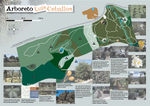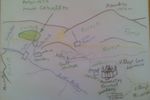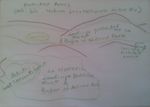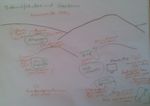Planting Design 2013 Working Group 24 - Case Study C
---> back to group page working group 24
Arboreto Luis Ceballos. A Botanical Garden in a landscape protected area.
| Name | Arboreto Luis Ceballos | |
| Location | Monte Abantos, Sierra de Guadarrama | |
| Country | Spain | |
| Authors | Francisco Felipe | |
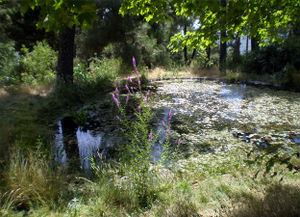
| ||
|
| ||
Rationale: Why is this case interesting?
The Arboreto Luis Ceballos is a public Botanical Garden and Environmental Education Centre located at the Mount Abantos, in the mountains northwest of Madrid. It holds a collection of around 250 different species of trees and shrubs native to the Iberian Peninsula, Balearic Islands, and a few adapted from the Canaries, planted since 1994, all together with the trees and other plants already existing on the zone. The arboretum stretches over 3.8 hectars at 1300 m altitude, amid an area reforested during the end of the XIXth and early XXth centuries mainly with pine and ash-trees, maples and other trees. The whole mountain and surrondings is a nature and landscape protected site and holds several endangered and endemic species of plants and animals, including a relictic forest of sweet chestnuts, as well as historical gardens created by the Spanish Kings since the XVI century.
The arboretum itself is interesting as a case study due to the planting conceptions developed there along the time as an educational resource, and specially in relation to the surrounding historical sites and gardens, as well as the protected natural area and forests.
I have a direct relationship, living in the same mountain and having seen the contrasts and evolution on the area in the recent times.
Author's perspective
I am interested in the different situations in the zone, being together historical gardens, natural forests, reforested areas, exotic trees... and the whole disruption caused by the strong growth of the once small villages in the zone. There is a strong conflict between heritage (nature & historical sites) and urban growth. Landscape Architecture would be an important tool in this context, togehter with Environmental Education and Public Use strategies; the Arboreto Luis Ceballos is interesting in this sense.
Professionaly I was in charge of the gardening and planting almost 3 years at the arboretum and I organise currently Environmental Education and Interpretation of the natural and cultural heritage activities in the area, as well as reforesting campaigns with environmental NGO's* since 2004 (planting indigenous trees and their botanical associations I produce in my nursery from seeds collected in the natural ecosystems on the area, reforesting a place where the forest was burnt in 1999), as a way to help to restore the environment and landscape and to foster empathy to Nature and environmental awareness in the local population.
*See http://arbasierra.blogspot.com.es/2013/12/seguimos-plantando-en-el-monte-abantos.html http://entornoescorial.blogspot.com.es/2013/12/plantamos-arboles-en-la-nueva_1.html
Landscape and/or urban context of your case
- Biogeography, cultural features, overall character, history and dynamics
The Arboreto is located at 1300 m altitude in the Mount Abantos (1753 m), at the Sierra de Guadarrama range, in Central Spain (provinces Madrid and Ávila). on the supramediterranean bioclimatic level (according to the classification form Prof. Rivas Martínez), which climax is constituted by forests of the melojo oak tree (Quercus pyrenaica) in the association Luzulo forsteri-Quercetumpyrenaicae sigmetum, with the southern wood-rush Luzula forsteri on acid to subacid soils (tipically here pH 6 to 6.5, over gneiss and granite) the association includes species as Acer monspessulanum, Amelanchier ovalis, Sorbus aucuparia, wild Prunus avium, Prunus spinosa, Juniperus communis, Erica arborea, Paeonia broteroi. Above the oak, on the oromediterranean level, the association of the Guadarrama subespecies of ScotPine (Pinus sylvestris) with Cytisus oromediterraneus, Genista cinerea, dwarf Juniperus alpina and grasslands of Deschampsia flexuosa and Nardus stricta. Below, the mesomediterranean level of the Holm oak (Quercus ilex ssp. ballota bearing often sweet acorns) with Juniperus oxycedrus and Retama sphaerocarpa, with scattered Quercus faginea. On the slopes of Abantos King Philip II built 1563-1584 the Royal Monastery of San Lorenzo (St. Lawrence) [1] to which were attached big extensions of land and forests, sothat still today it is possible to understand this territory (surronded by a historic wall [2]) as a whole, with cultural and environmental protection. The UNESCO entitled the Monastery and site as World Heritage Site in 1984. This historical context shaped very much the place, with several relevant monuments and historical gardens, as well as the nature (which were royal and monastic belongings for hunting, wood and cattle pastures. In the second half of the XVIII Century a new town was created by Charles III, San Lorenzo de El Escorial, close to the Monastery, which together with the old village of El Escorial have grown since and spread over the territory, specially in the recent years at cost of nature and landscape. In 1869 the Forestry Engineering School moved its headquarters to some of the historical buildings and began to aforest big extensions of the mountain, with indigenous and foreign trees, being another influence in the landscape shape.
- Illustration: Map; sketches; short descriptive analyses
The Arboreto was opened to the public in 1996 with 1.5 Has, soon after a new zone inside was readapted in order to show the most representative trees of each of the Spanish regions. In 2005 a new attached area of 2.3 Has was opened, showing the succesion stages of the plants and fitosociologic associations at the Sierra de Guadarrama, another part was debouted to etnobotanic uses of natural plants, as well as a mountain pond was naturalised with indigenous acuatic and water margins plants, most of them existing as well in other European countries (Nymphea alba, Nuphar lutea, Potamogeton natans, Lemna minor, Ceratophyllum demersum, Typha latifolia...). The pond is habitat for several endangered amphibia, some of them endemic.
Analytical drawings
- Analytical Drawings
Projective drawings
The mount Abantos is the result of long term natural dinamics and human interaction, with te results of deforestation in the past and aforestation since the last and a half centuries. The aforestation has been done under forestry engineering and water protection criteria, this was necessary at that point, but nowadays becomes important to change towards a more ecological concept, as to foster the natural sucession and self-regeneration of the forests and ecosystems, as well as the leisure and educational aspects of Public Use. Plantig dessign and landscape managment concepts (the Mount Abantos is a Landscape protected area and has a natural protection as a buffer zone for the newly declared Sierra de Guadarrama National Park, as well as the whole zone is inside the Natura 2000 network of the EU) are an opportunity to go on that way, combining both aspects, Ecology and Public Use, and as a way to gradualy remediate the severe landscape impacts caused by the strong contruction wave on the last decade in Spain. This is also the 'background' scenary from one of the mayor historical monument complex in Spain, the Monastery of El Escorial, UNESCO's World Heritage Site.
My wihses in this sense is that the Arboreto could be a kind of 'template' or inspiration to stablish those ecological criteria, both due to the relevant collection of plants, some of them rare, and because the management it has followed during 20 years now. I envision, as well, in the long run a slow, progressive colonisation of the Arboreto surroundings by some of those plants. In the next couple of years I only can forecast a growth of the plants (and a challenge for the present coordinators in order to preserve with less, limited economic resources) all the achivements got until now. In a longer term, I hope on a bigger influence in the population and the public officers in charge on forest management decissions.
- Projective Drawings
Summary and conclusion
The Arboreto looks to me like a kind of safe zone, an oasis in the middle of the mountains, an island of biodiversity. Due to the recent and current severe impacts in the landscape (mainly because of the erratic, out of control growth of the villages, and the complicity of local politicians and builders, which ultimately caused the economical crisis in this country) such a place can become a reference and educational tool. More precisely, under a Landscape Architectural prospective, the Arboreto serves as an inspiration for dessign and management in tune with Nature and the natural processes.
Image Gallery
- Image Gallery
References
Arboreto Luis Ceballos[3] Royal Monastery of El Escorial[4] Monastery[5] Casita del Príncipe Palace, Gardens and Orchards[6] Casita del Príncipe[7] Casita del Infante Palace[8] Casita del Infante Gardens[9] Nature[10] Historical Heritage[11]
About categories: You can add more categories with this tag: "", add your categories
